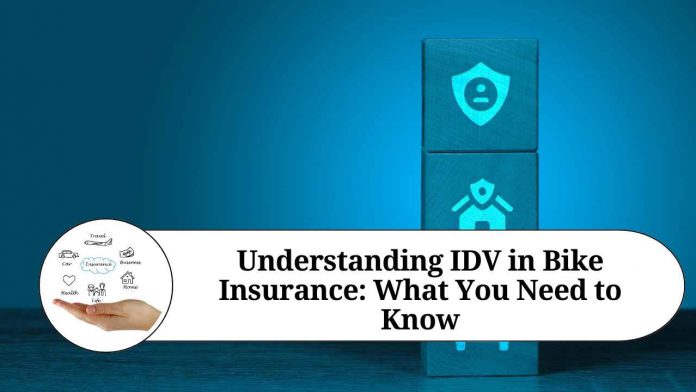Introduction
When it comes to protecting your bike, having the right insurance is crucial. Bike insurance provides financial coverage in case of accidents, theft, or damage to your beloved two-wheeler. However, while exploring various insurance options, you might come across the term “IDV.” IDV, or Insured Declared Value, plays a significant role in determining the premium you pay and the coverage you receive. In this blog post, we will delve into the concept of IDV in bike insurance and its importance in safeguarding your valuable asset.
What is IDV?
Insured Declared Value (IDV) is the maximum amount that your insurance provider will pay you in case of a total loss or theft of your bike. It represents the current market value of your two-wheeler after deducting the depreciation based on its age and condition. In simpler terms, IDV is the approximate sum assured that you would receive from your insurance company.
Significance of IDV:
Determining Premium: The IDV directly affects the premium you pay for your bike insurance. The higher the IDV, the higher the premium, and vice versa. This is because a higher IDV implies a larger potential payout for the insurance company in case of a claim.
Coverage Assessment: IDV helps assess the extent of coverage you would receive for your bike. If your bike gets stolen or completely damaged, the insurance company will compensate you up to the IDV. It is essential to choose an IDV that adequately reflects the market value of your bike to ensure sufficient coverage.
Factors Influencing IDV: Several factors contribute to the determination of the Insured Declared Value:
Bike’s Age: As your bike ages, its market value decreases due to depreciation. The IDV is calculated by taking into account the manufacturer’s listed selling price and adjusting it based on the age of the vehicle.
Bike’s Condition: The overall condition of your bike, including wear and tear, modifications, and maintenance, influences the IDV. A well-maintained bike may have a higher IDV compared to one in poor condition.
Market Value: Fluctuations in the market value of two-wheelers can impact the IDV. Insurance companies consider market trends, demand, and availability of similar bikes while calculating the IDV.
Tips for Choosing the Right IDV:
Research Thoroughly: Gather information about the current market value of your bike model. Compare prices, consider depreciation rates, and make an informed decision.
Consult Insurance Experts: Seek advice from insurance professionals or agents who can guide you on selecting an appropriate IDV based on your bike’s age, condition, and market value.
Strike a Balance: While it may be tempting to lower the IDV to reduce the premium, it’s crucial not to undervalue your bike. Opting for a significantly lower IDV may result in inadequate coverage during an unforeseen event.
Conclusion
Understanding the concept of Insured Declared Value (IDV) in bike insurance is vital for every bike owner. It determines the coverage you receive and the premium you pay. By accurately estimating the IDV, you can ensure that your bike insurance adequately safeguards your valuable asset. Take the time to research and consult experts to make an informed decision and choose the right IDV that offers comprehensive coverage and peace of mind while you ride on the open roads.
Read more useful content:
Frequently Asked Questions (FAQs)
Q1: What is IDV in bike insurance?
A1: IDV stands for Insured Declared Value. It is the maximum amount that an insurance company will compensate you in case of a total loss or theft of your bike. It represents the current market value of your bike after accounting for depreciation.
Q2: How is IDV calculated in bike insurance?
A2: The IDV is calculated by considering the manufacturer’s listed selling price of the bike and adjusting it based on the age and condition of the vehicle. Depreciation is applied to determine the current market value.
Q3: How does IDV affect the premium in bike insurance?
A3: The IDV directly influences the premium you pay for bike insurance. A higher IDV leads to a higher premium, while a lower IDV results in a lower premium. This is because the insurance company takes into account the potential payout in case of a claim.
Q4: Can I choose the IDV for my bike?
A4: In most cases, the insurance company provides a default IDV based on the bike’s age and model. However, you can usually request an increase or decrease in the IDV within a certain range, depending on the insurer’s terms and conditions.
Q5: What factors affect the IDV of a bike?
A5: Several factors influence the determination of the IDV, including the age of the bike, its condition, and the market value of similar models. Depreciation, wear and tear, modifications, and maintenance history are also taken into account.
Q6: Why is it important to choose the right IDV for my bike?
A6: Choosing the right IDV is crucial as it determines the extent of coverage you receive in case of a claim. If the IDV is too low, you may receive insufficient compensation. On the other hand, an inflated IDV may lead to a higher premium without providing any additional benefit.
Q7: Can I change the IDV during the policy term?
A7: No, you cannot change the IDV during the policy term. The IDV is generally fixed at the time of purchasing or renewing the insurance policy. It is advisable to review and update the IDV at the time of policy renewal based on the bike’s current market value.
Q8: How often should I review and update the IDV?
A8: It is recommended to review and update the IDV annually at the time of policy renewal. This ensures that the IDV accurately reflects the current market value of your bike and provides adequate coverage.
Q9: Does a higher IDV guarantee better coverage?
A9: While a higher IDV may lead to a larger payout in case of a claim, it does not guarantee better coverage. Other factors, such as the policy’s terms and conditions, deductibles, and add-on covers, also play a crucial role in determining the extent of coverage provided by the insurance policy.
Q10: Can I negotiate the IDV with the insurance company?
A10: While you cannot negotiate the IDV directly, you can provide supporting documents, such as recent quotations or valuation certificates, to justify a higher IDV to the insurance company. Ultimately, the final decision rests with the insurer based on their internal guidelines and policies.




















